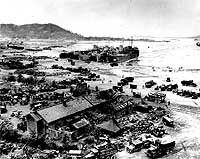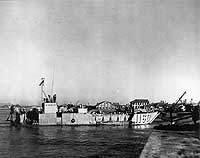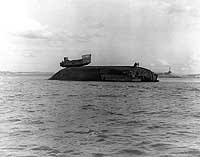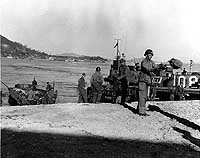
Once Inchon was secured, the port could be used to support further operations leading to the capture of Seoul and points beyond. Inchon's huge tidal range required that landing ships and craft be brought in on each high tide, to be left hard aground as the waters receded. Prompt unloading was then essential to permit their replacement on the next high tide by another batch of landing vessels. In addition, the high tides of mid-September would soon diminish, making much of Inchon's waterfront inaccessible to LSTs, the largest and most productive of the beaching vessels.
With careful planning and efficient execution, this scheme worked well. In the first week following the invasion, more than 25,000 tons of supplies, 6600 vehicles and 50,000 personnel came ashore at Inchon. The drive to Seoul was adequately supplied, and Inchon remained a valuable logistic asset throughout the rest of the year.
This page features views of operations at Inchon immediately following the 15 September 1950 invasion.
For a special image selection on the Inchon Invasion, plus
links to additional pictures of that Operation, see:
For views of other aspects of the September-November United
Nations' offensive in Korea, see:
For a precis of our Korean War images, and links to more
comprehensive pictorial coverage of that conflict, see:
| If you want higher resolution reproductions than the Online Library's digital images, see: How to Obtain Photographic Reproductions. |
Click on the small photograph to prompt a larger view of the same image.
|
Photo #: 80-G-420027 Inchon Invasion, September 1950 Four LSTs unload men and equipment while "high and dry" at low tide on Inchon's Red Beach, 16 September 1950, the day after the initial landings there. USS LST-715 is on the right end of this group, which also includes LST-611, LST-845 and one other. Another LST is beached on the tidal mud flats at the extreme right. Note bombardment damage to the building in center foreground, many trucks at work, Wolmi-Do island in the left background and the causeway connecting the island to Inchon. Ship in the far distance, just beyond the right end of Wolmi-Do, is USS Lyman K. Swenson (DD-729). Official U.S. Navy Photograph, now in the collections of the National Archives. Online Image: 161KB; 740 x 615 pixels Reproductions of this image may also be available through the National Archives photographic reproduction system. |
 |
|
Photo #: NH 97155 Inchon Invasion, September 1950 LSTs on "Yellow" Beach, on the Inchon waterfront, 16 September 1950. Second ship from the front is probably USS LST-914. Next beyond her is USS LSM-419. The other two LSTs present are Japanese-manned, and therefore unarmed. Official U.S. Navy Photograph, from the collections of the Naval Historical Center. Online Image: 112KB; 740 x 605 pixels |
 |
|
Photo #: NH 97157 Inchon Invasion, September 1950 LSU-1160 moves onto Inchon's "Yellow Beach" to land supplies, 17 September 1950. Taken by a photographer from USS Mount McKinley (AGC-7). Official U.S. Navy Photograph, from the collections of the Naval Historical Center. Online Image: 91KB; 740 x 610 pixels |
 |
|
Photo #: NH 97156 Inchon Invasion, September 1950 LCM stranded on the side of a sunken ship off Inchon, 17 September 1950. Its position, some twenty feet above the water level, shows the great tidal range that is typical of Inchon. Official U.S. Navy Photograph, from the collections of the Naval Historical Center. Online Image: 70KB; 740 x 605 pixels |
 |
|
Photo #: 80-G-467293 Inchon Invasion, September 1950 Troops unload landing craft at Inchon's Red Beach on 18 September 1950, three days after the initial landings there. The LCVP in the center is from USS Alshain (AKA-55). Wolmi-Do island is in the background. Official U.S. Navy Photograph, now in the collections of the National Archives. Online Image: 114KB; 740 x 610 pixels Reproductions of this image may also be available through the National Archives photographic reproduction system. |
 |
|
Photo #: 80-G-426159 Inchon Invasion, September 1950 A LST and a LCM are stranded by low tide near the Tidal Basin on Inchon's waterfront, during the post-assault logistics buildup, 20 September 1950. The LST (bearing the side number QO-18) is suspended on the end of a pier, with other landing craft beached nearby. Sowolmi-Do island is in the far right background, with invasion shipping visible in the distance. Official U.S. Navy Photograph, now in the collections of the National Archives. Online Image: 86KB; 740 x 610 pixels Reproductions of this image may also be available through the National Archives photographic reproduction system. |
 |
|
Photo #: NH 97158 Inchon Invasion, September 1950 Unloading operations on "Green" beach, Inchon, 20 September 1950. The beached ship is a Japanese-manned LST. USS Eldorado (AGC-11) is in the center distance. This view was taken by Bumpus, one of Eldorado's photographers. Official U.S. Navy Photograph, from the collections of the Naval Historical Center. Online Image: 75KB; 740 x 610 pixels |
 |
|
Photo #: 80-G-420481 Inchon Operation, September 1950 View of the transport area, looking southwestward from over Inchon, with Sowolmi Do in the foreground. The original photograph is dated 29 September 1950, two weeks after the Inchon assault and the day that liberation ceremonies took place in Seoul. USS Rochester (CA-124), flagship of Joint Task Force Seven, is in the center. USS Mount McKinley (AGC-7), flagship of Task Force 90, is the nearest of the three ships at left, seen straight out from the Sowolmi Do seawall. Official U.S. Navy Photograph, now in the collections of the National Archives. Online Image: 72KB; 740 x 610 pixels Reproductions of this image may also be available through the National Archives photographic reproduction system. |
 |
For a special image selection on the Inchon Invasion, plus
links to additional pictures of that Operation, see:
For views of other aspects of the September-November United
Nations' offensive in Korea, see:
For a precis of our Korean War images, and links to more
comprehensive pictorial coverage of that conflict, see:
| If you want higher resolution reproductions than the Online Library's digital images, see: How to Obtain Photographic Reproductions. |
Images added 23 January 2000